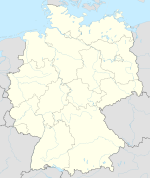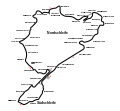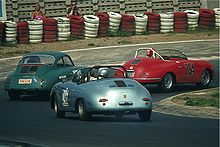Start-and-finish loop

Address: |
|
|
|
|
||
| Route type: | permanent race track | |
|---|---|---|
| Owner: | State of Rhineland-Palatinate and the district of Ahrweiler | |
| Architect: | Gustav Eichler, Ravensburg | |
| Start of building: | July 1, 1925 | |
| Opening: | June 27, 1927 | |
Formula 1 venue : |
1951-1976 | |
| Decommissioned: | 1982 | |
| Demolition: | 1982 | |
| Nürburgring start and finish loop | ||
| Route data | ||
| Route length: | 2.292 km (1.42 mi ) | |
| Curves: | 5 | |
| Curve superelevation: | 2 | |
| Records | ||
| Track record: (sports car) |
0: 47.8 min. (Herbert Müller, Porsche, 1974) |
|
| http://www.nuerburgring.de | ||
Coordinates: 50 ° 20 ′ 5 ″ N , 6 ° 56 ′ 40 ″ E
The start and finish loop (often also spelled “start and finish loop”) was a 2.292 kilometer long section of the Nürburgring race track that existed from 1927 to 1982 . It was built between 1925 and 1927 together with the Nordschleife and the Südschleife , whose connection it represented. It could also be used as an independent route. Since it had concrete slabs as a road surface until the 1950s, it was popularly known as the “concrete loop”.
When Super Sprint on September 8, 1974, she orbited Herbert Müller with a Porsche 917/30 TC in 47.8 seconds and an average speed of 172.619 km / h. The same lap time was achieved by Tim Schenken a year later .
The start-and-finish loop as part of the old Nürburgring
Together with the north and south loops, the start and finish loop represented the three historic parts of the Nürburgring track . The buildings required for racing, such as the start and finish house and pit area, were located on the start and finish loop , Paddock and others, so that races on the north and south loops could only take place in conjunction with the start and finish loop. The layout of the sections on the Nürburgring therefore only allowed one racing event at a time. Today's Grand Prix track and the Nordschleife, however, must be used separately.
As part of the Nürburgring, the start-and-finish loop could be used as follows:
- as an independent route (see info box)
- as the start and finish area of the entire route (Figure 1)
- as the start and finish area of the Nordschleife (graphic 2)
- as the start and finish area of the Südschleife (Figure 3)
As part of the use as an independent route, for example, automobile slaloms were held, which as a rule did not count as races in championships or the like.
Sections of the start-and-finish loop
Start-and-finish straight
Normally, all races at the Nürburgring started on the start-and-finish straight, regardless of whether they took place on the Nordschleife, the Südschleife, the start-and-finish loop or the entire route. The races began and ended on the line in front of the start-and-finish house.
The pit area was located parallel to the start and finish straight - without a guardrail until the early 1970s.
South turn
After the left turn at the end of the start and finish straight, it went straight into the south loop or right through the south turn on the back straight.
Back straight
The back straight ran parallel to the start and finish straight from the south bend and the end of the south bend to the north bend. At the end of the back straight, a left turn awaited the drivers.
North turn
After the left turn at the end of the back straight, the drivers either drove straight ahead in the direction of Hatzenbach on the Nordschleife or they turned right into the Nordkehre, which led back to the start-and-finish straight.
Connection with other parts of the route
- Südschleife : After the left-hand bend at the end of the start and finish straight, you could drive straight on to the Südschleife (instead of turning right through the south bend on the back straight). The Südschleife came back to the start-and-finish loop at the beginning of the back straight.
- Nordschleife : After the left-hand bend at the end of the back straight, you could drive straight onto the Nordschleife (instead of going right over the north bend back to the start and finish straight). The Nordschleife came back to the start-and-finish loop at the beginning of the start-and-finish straight.
Buildings at the start and finish loop (selection)
Since the start-and-finish loop represented the center of the Nürburgring, the buildings required for racing were also located here. These included:
- Start-and-finish house
- Pit system
- Main grandstand (with Sporthotel "Tribüne")
- Paddock (today: historical paddock)
Other well-known buildings on the start and finish loop:
- Continental tower (from 1950, replaced 1965)
- Dunlop Tower (from 1954)
- Mercedes-Benz press tower
modification
At the end of 1982, the demolition of the start and finish loop and the closure of the south loop began and the Grand Prix track was built in its place by May 1984 . Of the original facilities, only the historic paddock remains today.








